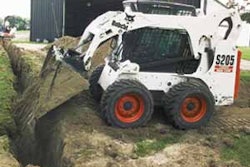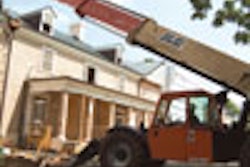The business of today's paving contractor is growing more difficult with each passing season. Seemingly being squeezed from all sides — longer hauling distances from the plant to the jobsite, complex mix designs using coarse aggregates prone to segregation and more stringent performance-based specs — contractors find it necessary to arm themselves with the latest technologies available in order to stay in business.
Although portable plants make it somewhat easier for contractors to obtain permits, finding a site for these plants can be difficult, especially in densely populated areas. The "not-in-my-backyard" attitude has pushed asphalt plants further away from paving jobs, with transport times of an hour or longer being the norm. This distance not only requires higher asphalt mix temperatures leaving the plant, but it also forces the paving crew to deal with thermally segregated material.
The growing popularity of performance-based specs calling for stone matrix asphalt (SMA) and Superpave mixes for highway, interstate and airport applications put more pressure on contractors to deliver a high quality mat that lasts. These tighter specs are a double-edged sword with the larger, coarser aggregate delivering more durable roads but are also more prone to segregate. Even by following proper paving techniques, unless contractors deal with particle segregation road service life will be shorter and more costly to maintain.
Feel the heat
Whereas material segregation is easily detectible by the naked eye, highway and airport paving contractors are employing techniques to identify the invisible form of segregation. Thermally-segregate material in the delivery truck results in uneven mat temperatures left behind traditional slat conveyor pavers, which make compaction more difficult.
With today's stricter tolerances of many state performance-based specs, there is a narrow window of opportunity for the rollers in the paving train. "There is about a 40-degree window for each roller to compact the mat to optimum densities," says Stuart Culver, project manager for Holmes & Murphy, an Orchard Park, NY-based paving contractor. If temperatures vary significantly across the mat, it's more difficult for the roller to compact at the right temperatures in order to reach spec densities.
Longer hauling distances greatly increase the chances for material at the top and sides of the truck to cool. In some cases, material at the core can be in excess of 50 degrees warmer than material at the outer edges of the delivery truck. Without some means of reblending the asphalt, meeting spec densities is nearly impossible.
This is a primary reason why paving contractors like Dublin, CA-based DeSilva Gates Construction utilize equipment like the Terex/Cedarapids Remix pavers from Terex Roadbuilding on tough performance-based contracts. Pavers with the Remix Anti-Segregation System are designed specifically to address both material and thermal segregation issues.
Two sets of twin counter-rotating augers in a Remix paver's hopper replace the traditional slat conveyor delivery system. Whereas slat conveyor systems pull material from the front of the hopper back, the reblending augers pull uniformly from all areas of the hopper and spread material over an area five times larger behind the screed. This reblending action virtually eliminates both material and thermal segregation, allowing the rollers to more easily compact the mat to spec densities.
CA long haul
DeSilva Gates recently used its 562 Remix paver on a seven-mile stretch of Highway 70 north of Sacramento. The job required approximately 100,000 tons of asphalt, which consisted of five inches of a 1.5-inch base mix, then two inches of a ¾-inch aggregate mix and finally a one-inch, open-graded top course for water dissipation and improved traction. The mix was laid in windrows and transferred to the paver's hopper by a Terex/Cedarapids MS2 Pick-Up Machine.
Using the coarse base mix increased the potential of material segregation. Pulling the mix from its Marrysville/Dantoni plant left DeSilva Gates with an hour and fifteen minute one-way travel time to the Highway 70 jobsite, which allowed portions of the mix to cool 25 to 50 degrees on the trip. "Under these conditions it would be next to impossible to successfully meet spec densities with a conventional paver," comments Matt Herrmann, vice president of Herrmann Equipment Inc., a Terex/Cedarapids paver dealer.
Long hauling distances and resultant thermal segregation are nothing new to DeSilva Gates, as the contractor now routinely trucks material over an hour to supply asphalt to its paving jobs in the Sacramento, Roseville and Auburn areas. Prior to purchasing the Remix paver, the paving crew had experienced problems with both thermal and material segregation when using the company's conventional slat-delivery pavers.
However it wasn't until a demo of the Remix paver on an application in Oakland that DeSilva Gates learned the benefits of reblending the material. "They had problems meeting spec densities on that job prior to the demo," recalls Herrmann. "During the demo, the Port of Oakland inspectors thought DeSilva Gates fixed the problems at the plant, but the only change was using the Remix paver instead of a slat paver."
Purchasing the paver and using it on Highway 70 proved advantageous for DeSilva Gates. "Reblending the material with our Remix paver has eliminated the thermal as well as material segregation that we experienced in the past," says Jim Alves, paving manager for DeSilva Gates. "Now temperature differential across a 20-foot mat is less than five degrees, making it easier for us to meet spec densities."
Taking off
Across the country in Buffalo, NY, Holmes and Murphy purchased a Remix paver specifically for a difficult paving job at the Buffalo Niagara International Airport (BNI).
The $12-million project required 125,000 tons of asphalt to, among other projects, upgrade the crosswinds runway from Class B to Class A, lengthening it by 1,200 feet and installing an ILS system, so commercial aircraft can land. Due to the demands exerted on the runways and taxiways of an airport, the work at BNI followed stringent guidelines and included a Federal Aviation Administration (FAA) mix design, which demanded discipline placement.
More than 57,000 tons of a P-401B base course mix, consisting of a 2-inch minus coarse aggregate, was laid in two lifts, the first at four inches and the second at three inches. This FAA mix gets it strength from the aggregate and consists of less binder and fewer fines than a typical Department of Transportation mix.
While the 2-inch minus base course gets its strength and durability from the coarse aggregate, without disciplined placement it has a potential to segregate. This was a concern for Holmes & Murphy that never materialized. "The Remix paver handled any segregated mix coming out of the truck," says Culver.
Although the trucking distances were not as long at the BNI job as experienced with DeSilva Gates' Highway 70 application, mat temperature uniformity behind the paver was still a priority. The FAA required Holmes & Murphy to achieve a minimum 96 percent density across the mat and 92 percent density at the joints. According to Richard Holmes, president of Holmes & Murphy, "Our performance expectations of the Remix Anti-Segregation System were very high. The paver met our every expectation, and it helped us to meet the spec."
The paver's capability of reblending the aggregate delivered the additional benefit of making mat temperatures more uniform. "We used three methods to measure both surface and internal mat temperatures," explains Culver. "Mat temperatures at BNI were very uniform behind the Remix paver."
Reblending
A significant key to successfully meeting spec densities in a performance-based contract is the ability to reblend material that has segregated during transport. Uniform aggregate distribution throughout the mat will lead to a stronger, longer lasting road.
Better temperature distribution across the mat allows both the screed and rollers to achieve higher densities. "We achieved 85 percent density behind the Remix paver," comments Culver. The higher the density achieved at the screed translates into less time the rollers have to be on the mat to meet spec.
As experienced by DeSilva Gates and Holmes & Murphy, reblending material with the paver stops segregation with our without the aid of a material transfer device. More importantly, the paver can be used on the critical base course lifts, reblending the coarse aggregate to deliver a stronger road. This is not the case with some material transfer vehicles, which are too heavy to be used on the base.
If segregation occurs at the base lift, then the service life of the road suffers. "This is why states like Illinois, which have a spec requiring continuous paving on the final lifts, will spec the Remix paver on the base lifts," explains Bill Rieken, paver application specialist for Terex Roadbuilding. "It can eliminate any segregation of the larger base aggregates used for durability."
As specifications tighten, hauling distances increase and coarse aggregate mix designs with the potential to segregate are specified, material reblending becomes more of a necessity. When following proper paving techniques aren't enough to meet spec densities, then specialized equipment like the Remix paver can help a paving contractor. "Although we continue to use our conventional pavers on many applications, we will definitely use the Remix paver when we encounter another job with tough performance-based specs like the ones at BNI," says Holmes.
Information provided by Mark Hunt, general manager, asphalt mobile equipment for Terex Roadbuilding. Mark has 17 years of asphalt industry experience.




















